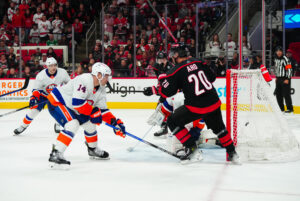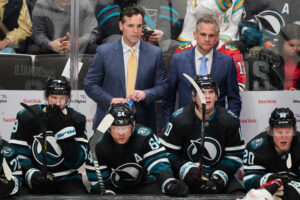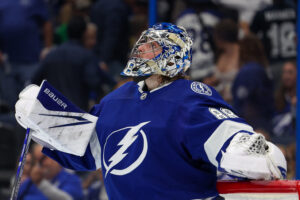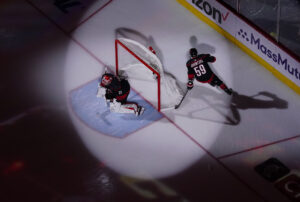Player development seems to always result in more questions than answers. How likely is it for a top pick to pan out? What makes a player a “steal”? Last Word On Hockey will be starting a new series on how to properly develop prospects from all different spots throughout the draft. This week’s piece involves top-10 picks and how they were used early in their careers.
Player Developments of Top 10 Picks
In the span of 2005 through 2015, there were 40 total selections made between fourth overall and tenth overall on forwards playing in North America. Of those 40 selections, six players were deemed not NHL-ready after one additional season outside of the NHL following the draft. Those players were Ryan Johansen, Gilbert Brule, Nick Ritchie, Brett Connolly, Nino Niederreiter, and Colin Wilson. In this piece, Last Word will look at Connolly, Niederreiter, and Wilson.
Player Development of Brett Connolly
Connolly, drafted sixth overall by the Tampa Bay Lightning in the 2010 NHL draft, has had a very up-and-down NHL career. Before he was drafted, in his DY-1 season, Connolly played with the Prince George Cougars of the WHL. In 65 games, he scored 30 goals and assists for 60 points. That was good for a 0.923 point-per-game pace, ranking 20th out of the aforementioned 40 selections in DY-1 production. He followed that up with 10 goals and nine assists for 19 points in just 16 games with the Cougars. That was good for a 1.188 point-per-game pace, ranking 26th out of those same 40 forwards in DY production. He missed games due to hip issues.
Connolly was given another season in juniors after the injury-riddled campaign he had in his DY season. In his DY+1 season, he would be given the captaincy, playing in 59 games and recording 46 goals and 27 assists for 73 points. That total was good for 1.237 points per game, ranking 25th out of the 30 remaining forwards yet to make an NHL roster full-time. Following this season, the Lightning would make Connolly a full-time NHLer.
How Was Connolly Used?
In his rookie campaign, Connolly would score four goals and 11 assists for 15 points in 68 games with the Lightning. He did that while averaging just 11:28 time on ice per game. His analytics were bad, however. He was below replacement level in even-strength offence goals above replacement (EVO) and even-strength defence goals above replacement (EVD). His EVO was -1.3 and his EVD was -1.9. With his even-strength play being so poor, his overall analytics were also bad. His goals above replacement (GAR) and wins above replacement (WAR) were both below replacement level, at -4.2 and -0.7, respectively.
Due to his really poor analytics, Connolly played mostly in the AHL in his second pro season, playing just five NHL games. He scored just one goal. In 71 AHL games, he scored 31 goals and 32 assists for 63 points. Unfortunately, he didn’t play enough games for his analytics to be recorded for the season.
AHL Seasoning Brings NHL Success?
Connolly, with a full season in the AHL to regain confidence and adjust his game, was expected to be ready to take the NHL by storm. That was, in fact, not the case. He played just 11 games, scoring one goal. He ended up back in the AHL for 66 games, scoring 21 goals and 36 assists for 57 points. In those 11 NHL games, Connolly yet again finished below-replacement level in all four analytics looked at. His EVO was -0.9 while his EVD was -0.2. Meanwhile, his GAR was down at -1.3, and his WAR is down at -0.3.
Following those first three seasons, he would remain with the Lightning for just 50 more games, scoring 15 points, before joining the Boston Bruins. He would play 76 games across two seasons with Boston, scoring nine goals and 18 assists for 27 points. Then, he joined the Washington Capitals, playing 217 games across three seasons, scoring 52 goals and 44 assists for 96 points. The last three seasons he has played for the Florida Panthers and Chicago Blackhawks, and this season he’s been relegated to the Rockford Icehogs of the AHL.
Player Development of Nino Niederreiter
Niederreiter, drafted fifth overall by the New York Islanders in 2010, has been a solid NHLer for quite some time. It started in his DY-1 season, where he recorded 20 goals and 14 assists for 34 points in 30 games with Davos U20 in the Elite Jr. A league in Switzerland. That was good for a 1.13 point-per-game pace, ranking 11th out of the aforementioned 40 forwards in DY-1 production, albeit in a European league. Niederreiter then came overseas to play for the Portland Winterhawks in the WHL in his DY. He recorded 36 goals and 24 assists for 60 points in 65 games. That was good for a 0.923 point-per-game pace, ranking 37th out of the same 40 forwards in DY production.
Due to Niederreiter’s difficult transition to the WHL and North American rinks, he was kept in the WHL for an additional season. In that year, he recorded 41 goals and 29 assists for 70 points in 55 games with Portland. That was a 1.273 point-per-game pace, ranking 23rd out of 30 forwards who were yet to be NHL regulars in DY+1 production. Following that season, Niederreiter was given a full-time NHL role.
How Was Niederreiter Used?
Niederreiter’s first NHL season was a very tough one. He played 55 games with the Islanders, scoring just a single goal. Niederreiter averaged 10:07 time on ice per game in that span. He played six AHL games at one point due to his struggles, where he scored three goals and four points. His analytics were absolutely terrible, with a -6 EVO and -4.1 EVD. His -6 EVO was the worst recorded rookie season EVO among all top-10 picks from 2005-2015. It wasn’t just even-strength where he struggled, as his WAR (-1.8) and GAR (-10.1) were also really bad. His WAR and GAR were the worst recorded rookie season analytics among top-10 picks as well, in that same span. He may have had the worst rookie season, ever.
Due to his abysmal rookie campaign, he would play his entire second pro season in the AHL. In 74 AHL games, Niederreiter scored 28 goals and 22 assists for 50 points. In the 2013-14 NHL off-season, Niederreiter was dealt to the Minnesota Wild for Cal Clutterbuck.
New Team, New Nino
Upon joining the Wild, Niederreiter went on to play 81 NHL games, scoring 14 goals and 22 assists for 36 points. He would average 14:06 time on ice per game, a solid role for a young kid looking to find a groove. His analytics were flipped a complete 180 degrees, recording a 6.9 EVO and 3.1 EVD. Meanwhile, his WAR (1.9) and GAR (10) were also polar opposites of his rookie campaign totals.
Following his first season in Minnesota, he would play another 353 games with the Wild over five seasons. He scored 96 goals and 96 assists for 192 points in that span. In the 2018-19 season, he was dealt to the Carolina Hurricanes, where he remains today. To this point, he has played 166 games with the Hurricanes, scoring 48 goals and 48 assists for 96 points.
Player Development of Colin Wilson
Wilson, drafted by the Nashville Predators seventh overall in the 2008 NHL draft, played for the US National Team Development Program in the USDP for his DY-1 season. In that season, he scored 19 goals and 31 assists for 50 points in 41 games played. That was good for 10th out of 40 forwards in DY-1 production, albeit against weaker competition than most. He followed that up by joining the Boston University Terriers in the NCAA for his DY. In 37 games, he scored 12 goals and 23 assists for 35 points, recording 0.946 points per game. That point-per-game pace ranked 35th out of 40 forwards in DY production.
Despite playing in a tougher league than most, he still ranked poorly amongst other top-10 draft picks, thus landing him back with Boston University for his DY+1 season. This time, he scored 17 goals and 38 assists for 55 points in 43 games, which is 1.279 points per game pace. That pace ranked him 20th out of 30 forwards for DY+1 production. The Predators would make Wilson a full-time pro following this successful, NCAA season.
How Was Wilson Used?
Splitting between the NHL and AHL, Wilson would see 40 games with AHL Milwaukee. There, he would score 13 goals and 21 assists for 34 points with the Admirals. Meanwhile, at the NHL level, he scored eight goals and seven assists for 15 points in 35 games. Wilson did that while averaging a solid 15:10 time on ice per game. His analytics were solid in his limited sample size, recording above replacement level in all four analytics looked at. His EVO was 1.6 and his EVD was 2.3, showing a two-way responsibility early in his career at even-strength. Overall, he posted a solid WAR (0.8) and GAR (4.6), though neither was truly mind-blowing.
In his second pro season, he would play strictly in the NHL. Playing 82 games, Wilson recorded 16 goals and 18 assists for 34 points, while averaging 13:18 of time on ice per game. While he received more minutes as a rookie, he was eased in with AHL time as well. Now a full-time NHLer, he was placed in sheltered minutes. His analytics improved with the sheltered minutes, recording a solid EVO (4.1) and EVD (3.1), maintaining his two-way effectiveness. His WAR (1.2) and GAR (6.6) improved further as he continued taking strides as an NHLer.
Wilson Continues to Blossom
Following a very successful sophomore season, Wilson would go into his third season with high expectations. He would play 68 games with the Predators, averaging 16:08 time on ice, as he was handed a bigger role. In that bigger role, Wilson recorded 15 goals and 20 assists for 35 points, a slight disappointment in terms of raw stats. But similar to his improvement from year one to two, his analytics saw a continuous improvement. His even-strength play was outstanding, recording a 7.1 EVO and a 3.7 EVD. Wilson also helped his team tremendously, providing a 2.2 WAR and 12.7 GAR.
Wilson would never truly break out offensively following his first three NHL seasons. His career-best point total came in 2014-15, scoring 42 points in 77 games with the Predators. His development is what the Anaheim Ducks failed to accomplish with Nick Ritchie. Ritchie may not have been an effective point producer early, and neither was Wilson. But the Ducks hit the panic button and tried to change Ritchie’s game while the Predators recognized Wilson’s effectiveness and stuck with it. Wilson has been a strong middle-six forward for a very long time, and he is providing his responsible play to the Colorado Avalanche.
Where are they now?
Niederreiter and Wilson are both still in the NHL, while Connolly currently plays in the AHL, as mentioned earlier. Niederreiter’s player development was not exactly great. Having struggled in a sheltered role as a rookie, he was immediately sent to the AHL for the entirety of the next season. While it paid off, and he had a really good year three, it’s always a risk to send a young player down like that. On the chance they keep him in the NHL and he plays part of the season in year two, he could’ve been even better with that experience.
Meanwhile, the player development of Wilson went about as well as it could have gone. Splitting between the NHL and AHL went a long way to find his identity. Then they closed in on what Wilson was really good at and put him in the right spots. It is exactly the way Ritchie should have been developed by Anaheim. Wilson was, and still continues to be, a solid NHL player.
Brett Connolly’s Player Development
Connolly, on the other hand, was not properly developed. Looking at Niederreiter, Connolly was going down a very similar path. His second year was spent almost entirely in the AHL. However, Niederreiter was given an opportunity in his third year, in a role that allowed him to thrive. Connolly was not. He was yet again relegated to the AHL ranks. The Lightning should have sent him to the AHL for part of the season in his rookie season rather than most of his second and third. Had he been sent down and split the year in his rookie year, that added confidence and experience against pros in the minors could’ve propelled him further for his second season.
Instead, he wasn’t, and he’s always been a below-average middle-six or bottom-six forward. Again, he finds himself in the AHL. He wasn’t good enough to make the Chicago Blackhawks roster, and they are 1-8-2. It’s fair to say, Connolly’s player development is not the best example.
Junior league stats via Elite Prospects, NHL stats via Hockey Reference, NHL analytics via Evolving Hockey
Main Photo: Embed from Getty Images






